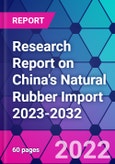In 2021, China imported 2.386 million tons of natural rubber, up 3.8% year-on-year, and the import value was US$3.86 billion, up 25.4% year-on-year. According to the publisher's analysis, in the first three quarters of 2022, China imported 1.838 million tons of natural rubber, up 10.3% year-on-year, and the import value was US$2.99 billion, up 11.1% year-on-year.
The publisher analysis, in 2018-2020, the average price of China's natural rubber imports remained in the range of US$1,300-1,400 per ton, which is generally relatively stable. 2021, the average price of China's natural rubber imports rose to US$1,617.4 per ton, an increase of 20.8% y-o-y. In the first three quarters of 2022, the average price of China's natural rubber imports was US$1,627.8 per ton, an increase of 0.8% y-o-y. The average price of Chinese natural rubber imports in the first three quarters of 2022 was US$1,627.8 per ton, up 0.8% year-on-year.
The four main types of natural rubber imported into China are natural rubber latex, smoked sheets, technically specified natural rubber (TSNR) and other shapes of natural rubber. According to the publisher's analysis, the main type of natural rubber imported into China in 2021 is technically specified natural rubber (TSNR). 1.448 million tons of technically specified natural rubber were imported into China in 2021, accounting for 60.7% of the total import volume and US$2.47 billion, accounting for 64.1% of the total import value in that year.
Southeast Asian countries are the main sources of natural rubber imports for China. According to the publisher's analysis, in 2021, China's major sources of natural rubber imports by import volume were Thailand, Malaysia, Cote d'Ivoire, Vietnam and Indonesia. Among them, Thailand is China's largest natural rubber import source. 2021, China imported 1.129 million tons of natural rubber from Thailand, accounting for 51.1% of the total natural rubber import volume and US$1.99 billion in import value, accounting for 51.7% of natural rubber import value.
As China's economy grows, market demand for natural rubber continues to be released. China has been the world's largest natural rubber consumer for many years, but China's domestic natural rubber production capacity can only meet less than half of the domestic market demand, and most natural rubber needs to rely on imports. The publisher expects that China's natural rubber imports are expected to continue to grow in 2023-2032.
Topics covered:
- China's Natural Rubber Import Status and Major Sources in 2018-2022
- What is the Impact of COVID-19 on China's Natural Rubber Import?
- Which Companies are the Major Players in China's Natural Rubber Import Market and What are their Competitive Benchmarks?
- Key Drivers and Market Opportunities in China's Natural Rubber Import
- What are the Key Drivers, Challenges, and Opportunities for China's Natural Rubber Import during 2023-2032?
- What is the Expected Revenue of China's Natural Rubber Import during 2023-2032?
- What are the Strategies Adopted by the Key Players in the Market to Increase Their Market Share in the Industry?
- What are the Competitive Advantages of the Major Players in China's Natural Rubber Import Market?
- Which Segment of China's Natural Rubber Import is Expected to Dominate the Market in 2032?
- What are the Major Adverse Factors Facing China's Natural Rubber Import?
Table of Contents
Methodology
Background research defines the range of products and industries, which proposes the key points of the research. Proper classification will help clients understand the industry and products in the report.
Secondhand material research is a necessary way to push the project into fast progress. The analyst always chooses the data source carefully. Most secondhand data they quote is sourced from an authority in a specific industry or public data source from governments, industrial associations, etc. For some new or niche fields, they also "double-check" data sources and logics before they show them to clients.
Primary research is the key to solve questions, which largely influence the research outputs. The analyst may use methods like mathematics, logical reasoning, scenario thinking, to confirm key data and make the data credible.
The data model is an important analysis method. Calculating through data models with different factors weights can guarantee the outputs objective.
The analyst optimizes the following methods and steps in executing research projects and also forms many special information gathering and processing methods.
1. Analyze the life cycle of the industry to understand the development phase and space.
2. Grasp the key indexes evaluating the market to position clients in the market and formulate development plans
3. Economic, political, social and cultural factors
4. Competitors like a mirror that reflects the overall market and also market differences.
5. Inside and outside the industry, upstream and downstream of the industry chain, show inner competitions
6. Proper estimation of the future is good guidance for strategic planning.

LOADING...








